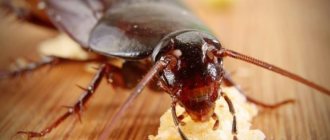Symptoms
Panic is the sudden appearance of a strong feeling of fear, internal discomfort in combination with the following diagnostic criteria (more than 4):
- dizziness, appearance of dark spots before the eyes, lightheadedness;
- complaints of subjective loss of strength in the limbs, numbness of the arms and legs, tingling of the skin (paresthesia);
- a feeling of obvious fear of losing your mind or not being able to control your actions;
- the appearance of “waves” of heat and cold in the body;
- fear of death - thanatophobia;
- loss of adequate orientation on the ground, in one’s own personality. a teenager cannot answer simple questions, for example, “What is your name?”, “Do you understand where you are?”;
- nausea, pain or discomfort in the abdominal area;
- trembling of the limbs and/or other parts of the body, accompanied by chills;
- feeling of lack of air, suffocation, difficulty breathing;
- severe sweating;
- rapid pulse, tinnitus due to the sensation of your own heartbeat;
- the appearance of pain, discomfort in the left side of the chest or in the heart area.
Children cannot always clearly describe what is happening to them, so the testimony of witnesses is of great importance. The average duration of an attack is 10-15 minutes. Teenagers are more susceptible to fear; at the time of the development of symptoms, they do not believe in their disappearance, expecting death.
Physical manifestations vary from person to person - from dry mouth to involuntary urination. After the attack, emotional “emptiness,” weakness, and a feeling of exhaustion may persist. The repeated nature of attacks or constant concern about their recurrence, which reduces the quality of life, is a sign of chronicity of the disorder.
Surveys
The diagnosis is largely based on the patient’s complaints and life history – a full psychiatric examination is required. In this case, it is advisable to listen to the testimony of family members and teachers. Older children often seek help on their own when there is fear of their parents or they are not interested in helping the child.
The chronic or paroxysmal course of the disease leads to the development of “defensive” behavior in children. They refuse to go outside, attend school, and need constant supervision. Gradually, fear loses its concrete outlines, and anxious tension remains permanently.
When collecting anamnesis, possible risk factors and genetic predisposition are found out, as well as current/past problems that dominate the adolescent’s mind. Laboratory and instrumental diagnostics are of secondary importance. A detailed physical examination is required to rule out physical causes of symptoms. The absence of organic pathology indirectly confirms the diagnosis of panic disorder.
What is a panic attack?
A panic attack is characterized by panic attacks that occur at least once a week.
A panic attack is a short (about 20 minutes) episode of intense fear (See Intrusive Thoughts and Fears) that is usually accompanied by physical symptoms such as rapid breathing, rapid heartbeat, sweating, chest pain and nausea. Panic disorder is diagnosed when children have panic attacks often enough to cause significant impairment.
Panic disorder is usually treated with a combination of medications and behavioral therapy with a psychologist (See Cognitive therapy in the treatment of panic disorder).
The problem is much more common among teenagers than younger children. Sometimes children experience anxiety (see Child and Adolescent Psychologist) when they are young and then develop panic disorder when they reach puberty.
Panic attacks can occur with any anxiety disorder (see Anxiety Disorders). For example, children with separation anxiety may have a panic attack when a parent leaves. Children who fear being trapped in places where there is no easy escape (agoraphobia) may have a panic attack when sitting in the middle of a row in a crowded classroom. Many children with panic disorder also have agoraphobia.
Physical disorders such as asthma can also cause panic attacks, and panic attacks can cause asthma attacks.
Panic disorder (PA) in children and adolescents is a chronic disease that is accompanied by psychosocial difficulties in both adolescence and adulthood (see Psychosomatics).
This article reviews the prevalence, clinical characteristics, risk factors, comorbid conditions, differential diagnosis, and treatment of panic attacks. Although PA is thought to be rare in children and adolescents, the prevalence of PA in community samples ranges from 0.5% to 5.0, and in child mental health clinics from 0.2% to 10%.
Panic attacks are reported to be equally common among men and women. Clinical studies have shown that the majority of pediatric patients with PsA consulted in clinics are older adolescents, women, and middle-class people.
Up to 90% of children and adolescents with panic attacks have another anxiety disorder (separation anxiety disorder, social phobia, or agoraphobia (see Agoraphobia and Panic Attacks)) or mood disorder (bipolar disorder). Patients with panic attacks may be misdiagnosed or have neurological, cardiovascular, pulmonary or gastrointestinal diseases. Comprehensive treatment is recommended, and the course and treatment of PA in children and adolescents should be further evaluated through well-designed studies.
Night attacks
Anxiety symptoms in some adolescents increase mainly at night. The clinical picture includes typical and individual symptoms. In this case, the following additional signs often appear:
- predominance of nightmares;
- waking up from a panic attack;
- insomnia due to fear of nightmares;
- involuntary urination, defecation;
- severe suffocation;
- sleep paralysis
Night attacks are more difficult for a child to endure, since fear is more intense in the dark. After a disturbing awakening, it is then impossible to fall asleep normally. Subsequently, children may experience fear before sleep and avoid staying in bed.
Children who have panic attacks during sleep should not be left alone. Lack of normal sleep can lead to the development of more severe diseases. Consultation with a psychotherapist is required.
It is extremely rare that panic attacks occur only during sleep.
It is necessary to distinguish panic attacks from nightmares. As a result, many patients with sleep panic attacks suffer from insomnia. As a rule, panic attacks tend to recur, and over time they occur more and more often, while the real reasons for their development can no longer be found. The frequency of attacks varies from daily to once every few months. Panic attacks in children / A.I. Smiyan, A.M. Yemets, Ya.S. Amelina, E.A. Lazebnik.
Symptoms and signs of a panic attack in children and teenagers
Symptoms of a panic attack include a sudden surge of intense fear accompanied by physical symptoms (eg, palpitations, sweating, trembling, shortness of breath or choking, chest pain, nausea, dizziness). Compared to those in adults, panic attacks in children and adolescents are often more dramatic (eg, screaming, crying, and hyperventilating). This can be extremely frightening for parents.
Panic attacks usually develop spontaneously, but over time, children begin to attribute them to certain situations and conditions. Affected children then try to avoid those situations that may lead to agoraphobia. Avoidance behavior is considered agoraphobic if it greatly interferes with normal functioning, such as going to school, going to the mall, or performing other typical activities.
During a panic attack, children experience intense anxiety, which causes physical symptoms:
- The heart is beating fast.
- Children may sweat profusely and choke
- They may have chest pain or dizziness, nausea or numbness
- Children may feel like they are dying or going crazy
- Things may seem unreal to them
- Symptoms may be more dramatic (including screaming, crying, or hyperventilation) than in adults
- Children may worry about other seizures
- Panic attacks and related worries interfere with relationships and schoolwork
In panic disorder, panic attacks usually occur on their own, without any specific trigger. But over time, children begin to avoid situations that they associate with seizures. This avoidance can lead to agoraphobia, which makes children reluctant to go to school, visit the mall, or engage in other typical activities.
Panic disorder often waxes and wanes for no apparent reason. Symptoms may go away on their own and then recur years later. But with treatment, most children with panic disorder improve.
Sometimes, when panic disorder is not treated, teenagers drop out of school, withdraw from society and become recluses and suicides.
Panic attack: causes of the disorder, treatment, prevention
How to behave during a panic attack and how to prevent it - says Mikhail Pertsel, chief freelance psychotherapy specialist of the Ministry of Health of the Sverdlovsk Region, head of the Sverdlovsk Regional Neurosis Clinic “Sosnovy Bor”.
Anxiety for no reason
– Mikhail Grigorievich, what is a panic attack (PA)?
– This is a neurotic disorder, which is expressed in attacks of anxiety and inexplicable fear in combination with somatic symptoms. It is based on a neurotic internal unconscious conflict.
Panic attacks can last anywhere from a few minutes to several hours, but on average they last about half an hour. Depending on the severity of the disease, attacks can be repeated 1–2 times a month or several times a day.
– What can cause PA attacks?
– PAs are not associated with specific situations; they appear unpredictably and spontaneously. They can even occur in a dream, when traveling in public transport, while at home, or in nature. Panic disorder, which manifests itself as PA, is a psychogenic disease that is not associated with a somatic disease of any organs or systems. Panic attacks often occur for no apparent reason, but they can occur against the background of stressful and traumatic events, emotional stress, and life difficulties. For example: situations of isolation from family, experiences associated with loneliness, increased responsibility, etc.
When a person encounters this, he should immediately contact a psychotherapist. In addition to a psychological examination, it may be necessary to conduct other examinations to exclude the presence of somatic diseases, such as increased levels of thyroid hormones and cardiovascular diseases.
– Who is more at risk of having a panic attack?
– People aged 25–60 years are susceptible to PA, more often women. According to recent data, the prevalence of panic disorder is from 2 to 5% of the population.
– How does a panic attack manifest?
– Symptoms of PA: a feeling of unreasonable fear and panic, chest pain, difficulty breathing, rapid heartbeat, increased pulse, increased blood pressure, dizziness, foggy consciousness, etc.
Often there is a feeling of lack of air, fear of death, a feeling that a person is no longer in control of his thoughts and his body, fear of going crazy. People who have suffered from PA often describe it as: “the ground disappears from under your feet,” “your heart is about to jump out of your chest,” “there is not enough air,” etc.
A person who has had a panic attack may experience secondary fear associated with anticipation of the next attack. Avoidance behavior may develop towards public places, being in crowds, large open spaces, and traveling alone. This is due to the fact that the thought often arises: “they won’t be able to help me during an attack, and I may die / lose control,” or these circumstances are perceived as a possible cause of an attack if it has already occurred in similar conditions.
– How to behave during PA?
– At the first signs, you should try to relax your muscles and breathe calmly. To relieve and prevent PA, the “7/11” breathing technique helps, when the exhalation is slightly longer than the inhalation in a ratio of 11 to 7. This is how a person gains control over his condition. If a person is already familiar with this condition, they should treat it as an unpleasant nuisance and not as a disaster, since panic attacks themselves and the accompanying symptoms are not life-threatening. During an attack, especially the first one, sometimes a person calls an ambulance. But most often, by the time the ambulance arrives, the patient feels better only from the knowledge that he will be saved.
– How to treat PA?
– If you are experiencing similar conditions, it is certainly worth seeing a doctor for an examination. The main thing is to remember that a panic attack will not lead to respiratory or cardiac arrest. This is an anxiety attack that will certainly end, and this can be helped by knowledge of ways to relax and find inner peace, and sometimes a course of certain medications.
Weak link
– Many people who suffer from PA claim that alcohol helps them relieve this condition. Is it so?
– I am categorically against this method. This method does not solve the problem, but temporarily pushes it into the background. The problem is not going away, and alcohol itself carries great risks. Unfortunately, many chronic alcoholics began by “relieving stress” in this way. Drinking alcohol is like sweeping trash under your bed. Each time it only becomes more.
At the first signs of a panic attack, you should try to relax your muscles and breathe calmly.
– Is it true that PA often develops after suffering from Covid?
– The consequences of Covid are varied, they affect all areas of human health. In the mental sphere, they can manifest as impairments in memory, attention, and performance in general; they can accelerate the development of dementia, and others. If we talk about the reasons for turning to a psychotherapist, it is depression, chronic anxiety or panic attacks. Among the alarming symptoms that you should pay attention to: unusual weakness, irritability, drowsiness, apathy. We must understand that during Covid infection the central nervous system is often affected. When these conditions are combined with an unfavorable psychological environment, the likelihood of chronic depressive and anxiety disorders increases.
– How to maintain your mental health?
– You need to develop competent critical thinking. Read useful books on psychology, get to know yourself better, find not only your “weak links,” but also your strengths and virtues. For example: a person notices that it is difficult to fit into a new team. Or perhaps we are talking about insufficient self-esteem, a biased attitude towards oneself. It’s good if “work on yourself” takes place with the help of a competent specialist. This is how a reasonable position and wise attitude towards life is formed, which will help you overcome any challenges and teach you to enjoy life.
AIF-Ural, 09/08/2021, M. Smirnova.
Diagnosis of panic attacks in teenagers
Panic disorder is diagnosed based on a history of recurrent panic attacks, usually after a physical examination to rule out physical causes of physical symptoms. Many children undergo significant diagnostic testing before panic disorder is suspected. The presence of other disorders, especially asthma, can also complicate the diagnosis. Careful screening for other disorders (eg, obsessive-compulsive disorder (See Coping with OCD), social anxiety disorder) is necessary because any of these disorders may be the underlying problem causing panic attacks as a symptom.
In adults, important diagnostic criteria for panic disorder include concerns about future attacks, consequences of attacks, and changes in behavior. However, children and young adolescents typically lack the understanding and forethought necessary to develop these functions, except that they may change behavior to avoid situations that they believe are associated with a panic attack.
Origins and physiology of panic attacks
Most often, the first attack develops during stress or during the period of anticipation of stress. An attack can be triggered by the use of alcohol, stimulants and an abundance of coffee, and of course - physical overload.
And yet, why for some people will this attack be a one-time attack and never happen again, while for others it will lead to a “serious illness”?
Some scientists talk about hereditary predisposition, but predisposition does not always mean the obligatory manifestation of the disease.
We are more inclined to consider another factor as the cause, namely, reversible changes in the central nervous system caused by disturbances in the metabolism of serotonin and norepinephrine. The reasons for the appearance of these changes can be considered mental trauma suffered in childhood and the personal characteristics of patients, which lead to the formation of a feeling of insecurity, childhood fears, and anxiety that affect stress resistance.
I would like to name one more reason - herniated intervertebral discs in the cervical spine, which affect the vertebral arteries and thereby disrupt blood circulation in the vertebrobasilar region. The cerebral cortex, brain stem, cerebellum, hypothalamic-pituitary region are in a state of constant hypoxia.
Main signs in children
A panic attack has the following symptoms:
- confusion of thoughts, loss of control over speech and emotions;
- heavy breathing, shortness of breath;
- rapid pulse, pressure surges;
- tremor, trembling, chills;
- sweating;
- nausea and dizziness;
- numbness of the limbs;
- dry mouth, pale skin;
- fear of going crazy or dying.
Children may exhibit several signs at once, as well as insomnia, depression, and depression. In this case, internal tension can persist for quite a long time. This phenomenon cannot be ignored, as it can result in a nervous breakdown or even suicide. During adolescence, a person begins to perceive the world as hostile, feeling lonely and abandoned.
Against the background of panic, unreasonable fears arise, which often develop into serious phobias. Panic attacks in adolescents are facilitated by behavioral stereotypes imposed from childhood. When a child tries to express emotions, parents scold him, saying “shut your mouth!” or “stop crying!”
Read more: Random acts of kindness
At an older age, they teach him that in any situation one must behave with restraint and decentness. Most parents conduct such education in a raised voice, in a rude, frightening form. As a result, the child’s self-esteem falls; he is afraid to express his opinion and express himself in society. He suppresses feelings and emotions, which in the future results in panic attacks.
Often seemingly quiet and calm teenagers commit stupid spontaneous acts, show aggression and cruelty.
Adults believe that such behavior is not typical for them, however, such manifestations most often occur in notorious teenagers, such “gray mice”. The volcano of constantly suppressed emotions must find a way out somewhere. A good option might be sports clubs, dancing or other activities that require physical activity. In this way, the teenager releases mental negativity and tension through the body.











